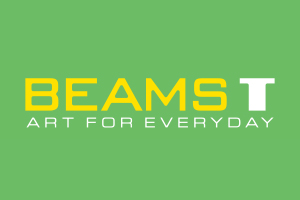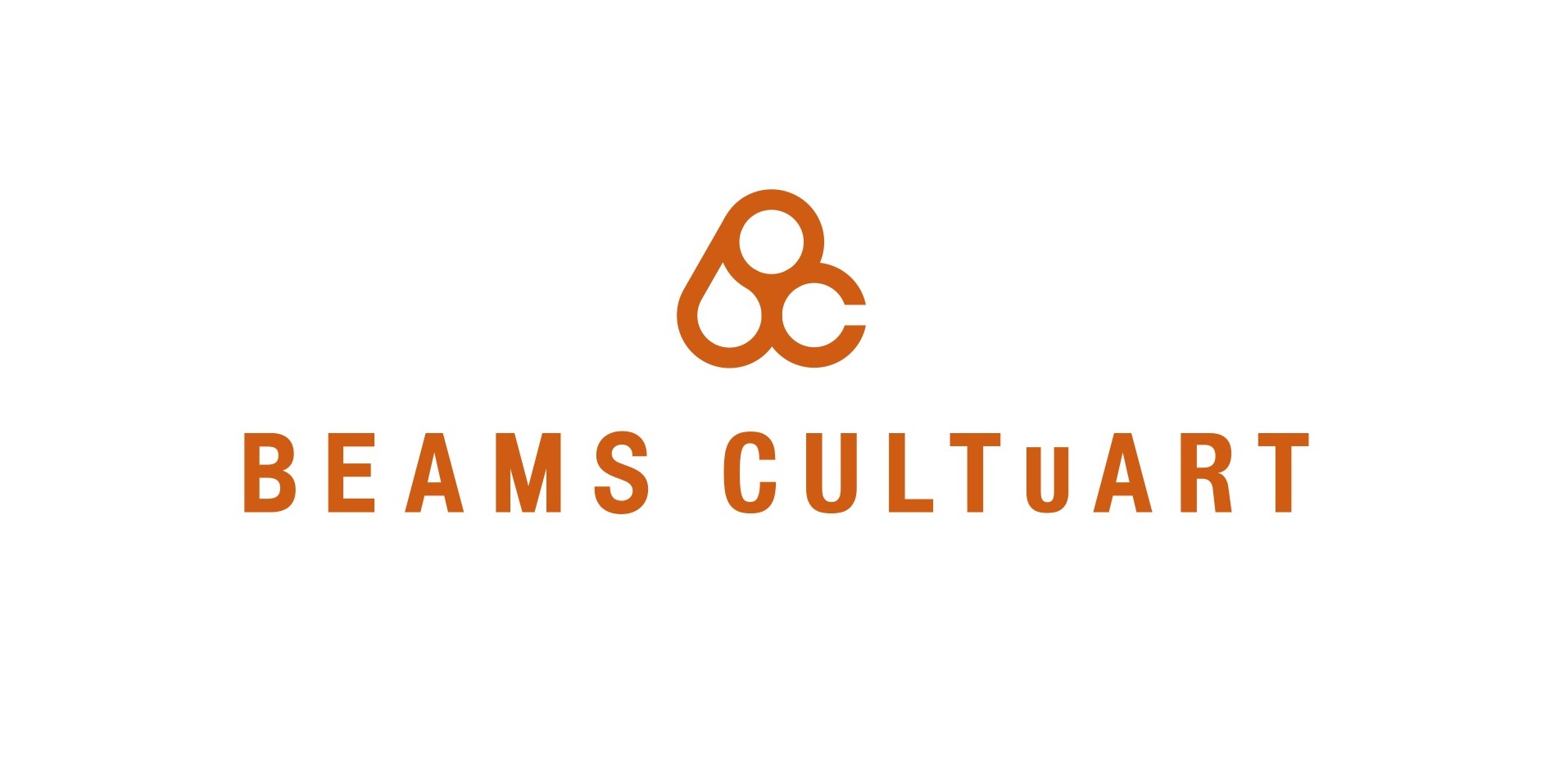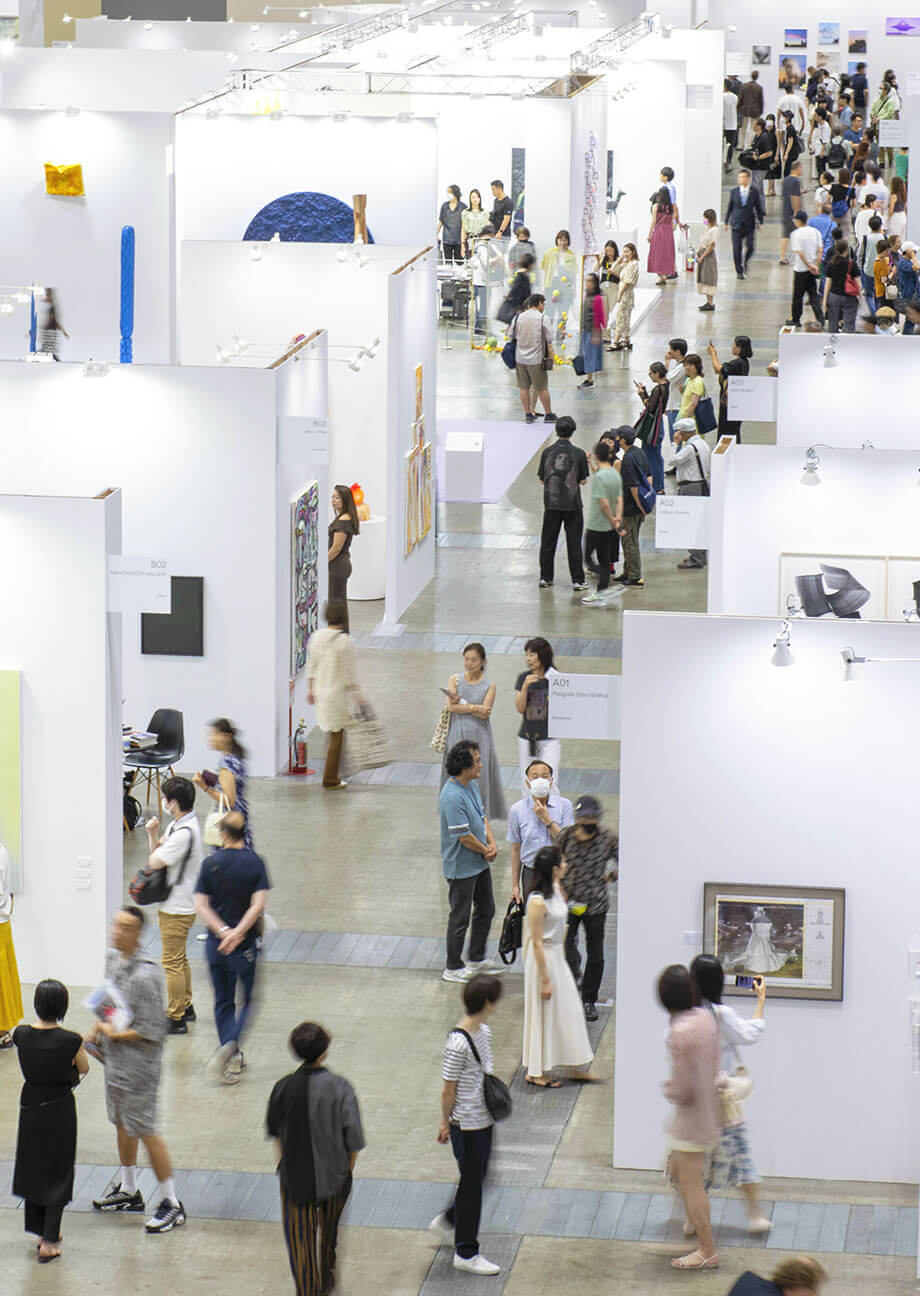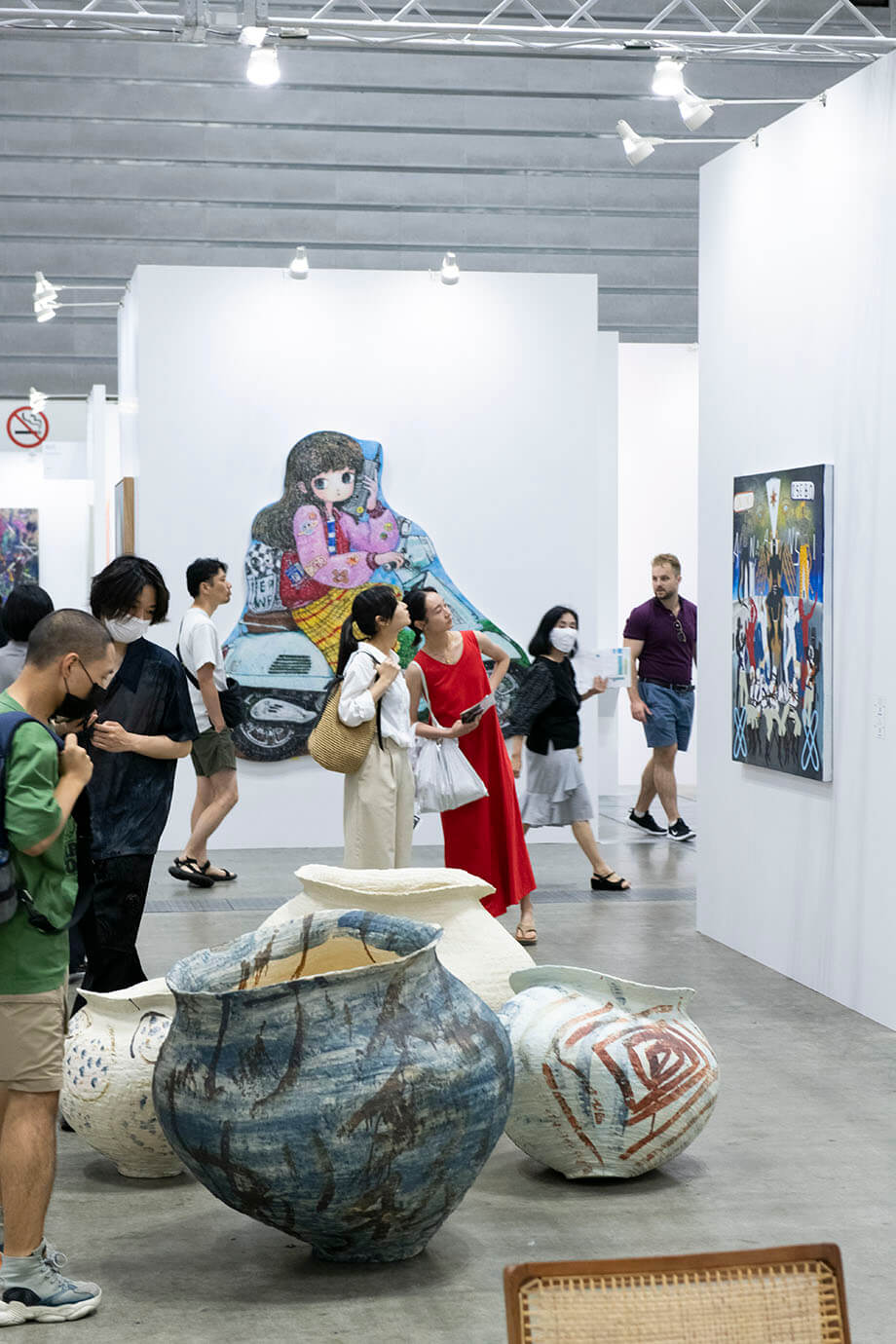

国際アートフェア「Tokyo Gendai」を楽しむために知っておきたいこと。
Things You Should Know to Enjoy the International Art Fair "Tokyo Gendai”
今このときも、作品が生み出され、裾野が広がり続ける現代アートの世界。時に心を動かし、時に煙にまくような現代アートを深く楽しむには、数多くの作品を直接観て、感じて、考えるという体験が大切です。でも、やはりそこには頼れるガイドが必要でしょう。作品を鑑賞し、購入することができる「Tokyo Gendai(東京現代)」は、厳選された世界の名だたるギャラリーや作品を一堂に集めた世界レベルの国際アートフェア。2024年7月5(金)〜7日(日)に横浜で開催される、このイベントのディレクターを務める高根枝里さんを迎え、どうすると「Tokyo Gendai」ひいては現代アートを楽しめるのか、アート好きなビームススタッフ2名と語り合いました。
Contemporary art is ever-evolving, with new works being created constantly, even at this very moment. To truly appreciate contemporary art, which can sometimes move you and other times leave you puzzled, it's essential to see, feel, and reflect on numerous pieces. Having a reliable guide can also be invaluable. "Tokyo Gendai," an international art fair, allows visitors to appreciate and purchase art from a curated selection of renowned galleries and artists from around the world. This world-class event will be held in Yokohama from Friday, July 5 to Sunday, July 7, 2024. We spoke with Eri Takane, the fair's director, and two art-loving Beams staff members to discuss how to best enjoy "Tokyo Gendai" and contemporary art as a whole.
PROFILE

中:高根枝里
(Tokyo Gendai フェアディレクター)
ニューヨーク大学大学院卒業。セゾンアートギャラリーのアートディレクター、日本のGoogle Arts & Cultureでプロジェクトマネジャーを歴任。「Tokyo
Gendai」第一回から、世界レベルのアートフェアを目指して、フェアディレクターに就任。
「Tokyo Gendai」Instagram
左:奥山ゆらら
(ビームスT 原宿 スタッフ)
秋田県出身。高校卒業後上京。兄の影響からメンズライクなファッションに興味を持ち「ビームスT 原宿」にアルバイト入社。休日はもっぱらカフェ巡り、ギャラリーを散策。アートの造詣を深めたく、日々奮闘中。
スタッフページ
右:吉田ゆり
(ビームス 新宿 スタッフ)
東京都出身。美術大学卒業後、服だけでなくアート作品も取り扱いのあるBEAMSに惹かれて2021年に入社。現在ものんびりとイラスト展示・制作活動中。好きな美術館は「東京都庭園美術館」。
Instagram
国際アートフェア「Tokyo Gendai」では何ができる?
ーまず「Tokyo Gendai」は、どんなイベントなのか教えてください。
高根:国際的なアートフェアで、去年に続き今年は2回目の開催です。70のギャラリーに出展していただき、内訳としては6割弱くらいが海外のギャラリーで、そのうち西洋とアジアが半々、残りが日本のギャラリーです。特色としては、日本ではなかなか見れなかったスケール感と海外色の強い国際的なギャラリーが揃っていること。海外のお客さんからすると、これだけの日本のギャラリーとアーティストに出会えるのは、滅多にない機会なのかなと。会場は横浜にある「パシフィコ横浜」の展示ホール C/Dです。約1万平米というかなりの広さがあり、各ブースがゆったりしていて、作品が見やすい環境です。これも世界基準のアートフェアの条件ですね。

ー広いということですが、会場の中はどのようになっているのでしょうか?
高根:会場内は大きく分けると、3つのセクターに分かれています。入って中央にあるのが、「Galleries(ギャラリーズ)」セクターと呼ぶ、著名なアーティストやギャラリーのある王道的なゾーン。そこから先に進むと、キュレーションされた展示のあるセクター「Eda ‘Branch’」があり、さらに奥には若手から中堅どころのアーティストやギャラリーまで揃うセクター「Hana ‘Flower’」があります。また、去年と違うのは、インスタレーションがひとつから5つに増えたこと。そのなかには歴史的な彫刻の作品もあれば、アーティストがパフォーマンスをするインスタレーションもあります。他にも観客とインタラクティブに会話をしながらできあがる観客参加型の作品があるなど、インスタレーションは今年の目玉のひとつです。
奥山:「Tokyo Gendai」に参加される、注目のギャラリーやアーティストをお伺いしたいです。
高根:まずは世界のトップレベルのギャラリーが見れるということで、大手グローバルギャラリーのひとつ「Pace Gallery」です。このギャラリーは今年「麻布台ヒルズ」にもオープンする予定で、日本にギャラリーをオープンすることはアート界隈ではかなり注目されています。若手のギャラリー・アーティストにも、面白いところはたくさんあるんですが、中でも今回初めて参加する「Alison Jacques」というロンドンのギャラリーのスペースで展示される、若手の女性アーティストのソフィー・バーバーさんの作品に注目しています。彼女は、アレックス・カッツさんやデイヴィッド・ホックニーさんといった著名なアーティストの作品を彼女のテイストにより再現する作品をつくっていて、作品のキャンバスに端切れを使っていたりと、環境にも配慮していて面白いなと。

Sophie Barber, A cake for the party, 2023, oil on canvas
Courtesy: Alison Jacques, London © Sophie Barber; photo: Michael Brzezinski
奥山:環境への配慮とか、いまの社会とも繋がっていますよね。
高根:そうなんです。あとは、去年から引き続き出展してくださっているギャラリーさんたちもたくさんいます。北京の「SPURS Gallery」のヤン・ダンフルさんというアーティストの作品も面白いですね。たとえば、ダンボールでできた宅配物のボックス自体を作品にしていて、それを刺繍ステッチで丁寧に再現されてるんですが、素材はダンボールだから見た目は本当にただの宅配物の梱包箱なんです。
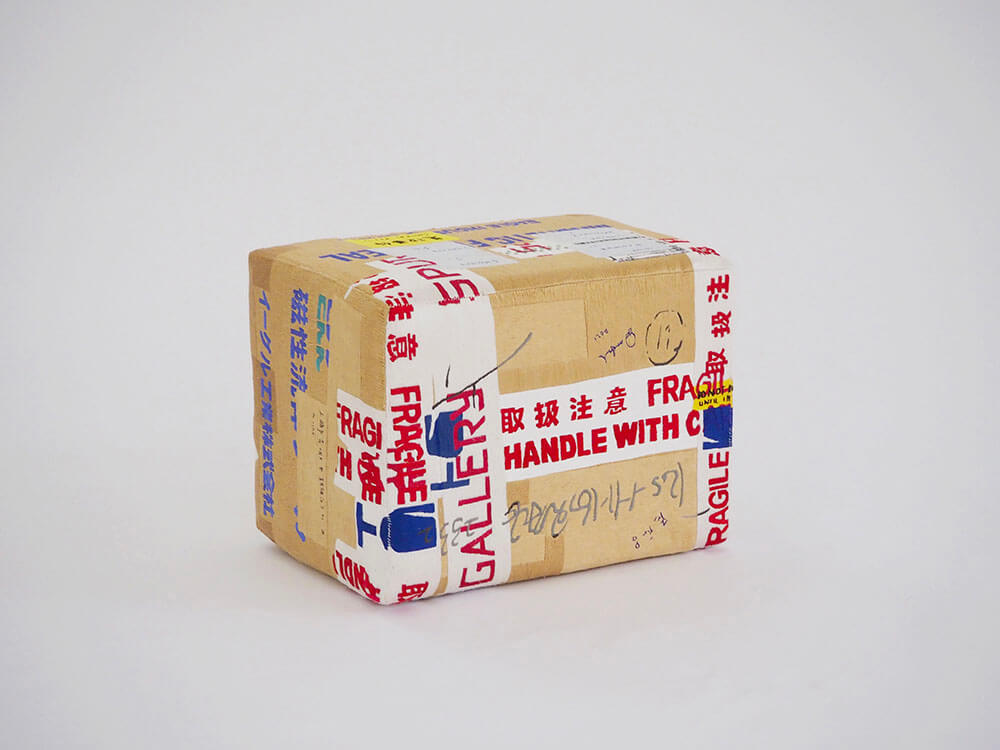
Danful Yang, Packing Me Softly, 2021
Hand embroidery on canvas, foam
Courtesy of the artist and SPURS Gallery
高根:でもコンセプトを知ると面白くて、中身は誰もが重視するけど、実際に守ってくれている外側はポイっと捨ててしまって、誰も注目しないと。たとえば、都市計画でもクリーニングする人たちにリスペクトを払わないのに、都心のクリーンさはみんなが求める。だから、本当に守ってくれている人たちにもうちょっと注目していこうというコンセプトが裏側にあります。このアーティストもそうですが、最近は面白い若手アーティストがどんどん増えてきている印象です。「Tokyo Gendai」では、大御所から注目の若手アーティストやギャラリーまで、そのミックス感も楽しんでもらいたいですね。
昨年の会場の様子。
Courtesy of "Tokyo Gendai"
ー アートフェアは、観るだけでなく作品を購入できるというのが美術館展示との違いですか?
高根:それは大きな違いだと思います。でも、それ以外にもあって、海外と日本のギャラリーがこれだけ一箇所に集まって作品を展示すること自体がアートフェアでしかありえません。私も学生時代は作品を買うなんてもちろんできなかったけど、観にくるだけでも楽しいイベントなので、作品を購入するかもしれないという未来を見据えて、鑑賞してもらえるといいかなと。作品によっては買いやすい価格のエディションがあるものもありますし、場合によっては持ってきていない作品を紹介してくれることもあります。ギャラリーとコミュニケーションを取れるのも魅力のひとつですね。
吉田:会場は、美術館のシーンとした静かな空間とは違いますよね。
高根:ガヤガヤしています。あとは、歩いて鑑賞していると、疲れるじゃないですか(笑)。「Tokyo Gendai」では、休憩したい時には、レストランでご飯も食べられるし、雑誌も置いてあるメディアカフェで休むこともできるんです。
改めて問う、現代アートとは?
ー現代アートと言っても幅広いと思うんですが、現代アートってなに? という質問には普段はどうやって説明しているんですか?
高根:うーん、それがまた面白さのひとつだと思うんですが、説明が難しいんですよね。多面的な側面があって人によって解釈も違いますし。ひとつ言えるのは、戦後から今に続いていて、素材から形態までジャンルレスというのは、現代アートのひとつの魅力だと思います。

奥山:私も休日にギャラリーに行くことがありますが、作品のどこに注目するといいのかが気になります。高根さんは、どこに注目して作品をご覧になりますか?
高根:すべての作品を観て覚えようとするのは多すぎて無理だと思うので、その中で自分の心が動かされる作品をしっかりと観ようと心がけています。だからキャプションからではなく、作品自体から観た方がいいと私は思いますね。キャプションを読むと先入観を持ってしまい、知識を蓄えて教育を受けるぞという感じになってしまうので。まずは自分が楽しむということがオススメです。
吉田:私も友達とギャラリーを回ったりしますが、難解なものも中にはあるよねって。だから知識がないと楽しめないと思ってましたが、今の話をお伺いして、全部を知らなくていいんだなと感じました。

高根:そうですね、そこから始めていいと思うんです。知りたいと思えば、自分で勉強するでしょうし、そうやってさらに面白くなっていきます。あと、年齢を重ねていくと同じ作品でも、若い頃と今と将来見た時で感じ方が変わってくるから、一生かけて楽しめますよ。絵日記的と言いますかね。私も最初はジェフリー・ダイチさんによる「Deitch Projects」でバリー・マッギーさんの作品と出合い、衝撃を受けて現代アートに興味を持っていったんですが、政治や環境、女性活躍など、ここ最近は自分のパーソナルなことに特に興味があります。たとえば、松川朋奈さん。同世代の女性にインタビューをして、そこからインスピレーションを受けた作品をつくっていたりして、自分と重なる部分に共感を覚え、実際に作品を購入させてもらいました。
アーティストはどんな気持ちなんだろう?
吉田:私もイラストの作品をつくっているんですが、たまにアート作品は高いよねと言われることがあるんです。購入以外でもアーティストを応援する方法はありますか?
高根:答えになっているかはわからないですが、私の場合はアーティストを応援するという感覚ではなく、一緒の目線でいることを意識しています。どちらが上か下かではなく、アーティストも観覧者・購入者も立場は一緒だから、お互いにインスピレーションを受けられたらいいなと。作品を購入する時にも、買わせてもらうという感覚も、買ってあげるという感覚もありません。アーティストだからと意識せずに、フラットに接するのが大事だと思います。アーティスト側は、作品について興味を持って質問をしてくれるだけでうれしいものです。

吉田:それはありますね。私の場合も、見た目だけの評価じゃなくて、私自身の思想やこれまでに積み上げてきた経験を作品に込めているので、作品を通して私を知ろうとしてくれるのがうれしいです。作品の中には、どこかアーティストの人生が表現されていると思うので。
高根:表現するというのは、勇気がいることですよね。作品を通して、自分の信じる部分をみんなに見せるのは、恥ずかしいところもあるだろうし、これでいいのかなって自信がない時もあるだろうし。そこで背中を押してくれる人がいることは、すごい大きな成長につながるはずです。人によりますが、アーティストは自分を表現したい気持ちと、自信がないという気持ちの両方持っている人が多いんだと思いますね。
ーアート作品は、誰かに頼まれてつくるものではないですからね。
高根:答えがない問いを投げかけなきゃいけないから大変な作業ですし、それをずっとつくり続けなきゃいけないというプレッシャーもあるでしょうね。デザインとアートの違いはそこかもしれません。デザインには答えがあって、消費者に突き刺さるようなデザインや言語が正解だと思うんですが、アートは質問を投げかけるだけなので、そもそも誰に響くのかもわからない。やっぱりアーティストって大変だなと思います。

ー 作品を購入して、自宅等の空間に置いて楽しむことの価値はどうお考えですか?
高根:作品は家の壁にかけると、「これいいな」というのと「今のタイミングじゃなかったかも...」というのが明確にわかるんです。作品を鑑賞・購入・飾るという一連を繰り返していくと、経験上わかってくるのかもしれないという感覚はあります。家に置いてみると面白いのが、印象の変化です。ひと目惚れ的に買った作品は、 置いてみると一カ月くらいすると一回仕舞おうかなということもあります。でも、自分のパートナーのような作品に出合えたら、家に置くと邪魔にもならないし、朝と夜で作品の印象が変わることもあります。そういうのは、購入してみないとわからないことだと思いますね。
Tokyo Gendaiまでもう一歩。
吉田:会場の「パシフィコ横浜」周りで前後に寄るといい場所はありますか?
高根:個人的におすすめなのが「三溪園」という、(実業家で茶人の)原三溪さんという方がつくった日本庭園です。モダン建築と素敵な庭園の組み合わせが素晴らしいんですが、おそらくあまり知られていないはず。あとは野毛の小さな飲み屋が集まったエリアもローカルの人たちがいらっしゃるらしく、帰りに一杯なんていいかもしれませんね。
昨年の会場の様子。
Courtesy of "Tokyo Gendai"
ー 最後に、改めて「Tokyo Gendai」の魅力を教えてください。
高根:最初にお話ししたことに加えると、アートトークという、トークプログラムがあるんです。初心者の方々も楽しめるような、面白いラインナップの人たちが登壇してくださる予定で、私も全員のトークを聴きに行きたいくらい。会場の隣のアネックスホールで開催され、「Tokyo Gendai」 のチケットをお持ちの方は無料で観ることができます。 あとは今回初めて子どもたちに向けたワークショップをやります。アーティストと一緒にアートをつくるワークショップをして、その後会場でそのアーティストの作品も観ることができます。いわば、子どもたちと一緒に遊んだ後に、実際に作品を観に行こうということです。小さな頃から、アート作品に触れてもらおうという試みのひとつです。
ー展示だけでなく、いろいろなイベントもあるということですね。あとは、ギャラリーも作品の数も多いから、それだけで面白い作品に出会える確率が上がるということですよね。
高根:その通りですね。あとは空間がオープンだから、緊張せずに自分のペースで作品を観ることができると思います。初めての方は、アートフェア全体の雰囲気を楽しむだけでも面白いですよ。そして作品に興味があれば、その場にいるギャラリストに気軽にお声がけくださいね!
INFORMATION
PROFILE

Middle: Eri Takane
(Tokyo Gendai Fair Director)
Graduated from New York University Graduate School. She has served as an art director at Saison Art Gallery and a project manager at Google Arts & Culture in Japan. Since the first “Tokyo Gendai,” she has aimed to create a world-class art fair as its director.
Instagram: @tokyogendai
Left: Yurara Okuyama
(BEAMS T Harajuku Staff)
Born in Akita Prefecture. She moved to Tokyo after graduating from high school. Influenced by her brother, she developed an interest in masculine fashion and joined “BEAMS T Harajuku” as a part-time employee. On her days off, she enjoys visiting cafes and exploring galleries. She strives to deepen her understanding of art every day.
https://www.beams.co.jp/staff/4048/
Right: Yuri Yoshida
(BEAMS Shinjuku Staff)
Born in Tokyo, she joined “Beams” in 2021 after graduating from an art university, attracted by its focus on both clothing and art pieces. She continues to illustrate and exhibit her work for pleasure. Her favorite museum is the Tokyo Metropolitan Teien Art Museum.
Instagram: @yurarihyon_bsc
What Can You Do at the International Art Fair “Tokyo Gendai”?
First, please tell us about “Tokyo Gendai.”
Takane: It’s an international art fair, now in its second round following last year’s debut. We have 70 galleries participating, with about 60% being international galleries—roughly half from Western countries and half from Asia—while the remainder are Japanese galleries. One distinctive feature is the scale and strong international presence of galleries not commonly seen in Japan. For overseas visitors, it’s a rare opportunity to encounter such a range of Japanese galleries and artists. The event takes place in Exhibition Halls C/D of Pacifico Yokohama in Yokohama. The venue spans approximately 10,000 square meters, providing spacious booths and an environment conducive to viewing artwork. These are all criteria typical of world-class art fairs.

You mentioned spaciousness, but can you tell us more about the inside of the venue?
Takane: Inside the venue, there are three main sections. Right at the entrance, there’s the “Galleries” section, featuring well-known artists and galleries—a classic zone. Moving further in, there’s the “Eda ‘Branch'” section with curated exhibitions, and deeper inside, you’ll find the “Hana ‘Flower'” section, which showcases emerging to mid-career artists and galleries. One notable difference from last year is the increase in installations, from one to five. These include historical sculptures and installations where artists perform. There are also interactive artworks that evolve through conversations with the audience, making installations a highlight this year.
Okuyama: I’d like to hear about the notable galleries and artists participating in “Tokyo Gendai.”
Takane: Among the top-tier global galleries, there’s Pace Gallery, which is also scheduled to open in Azabu Dai Hill this year, drawing considerable attention within the art community. There are many interesting emerging galleries and artists, too. I’m particularly interested in the works of Sophie Barber, a young female artist exhibiting in the space of Alison Jacques, a gallery from London participating in Tokyo Gendai for the first time. She creates artworks that reinterpret pieces by renowned artists such as Alex Katz and David Hockney in her own style, using fabric scraps as the canvas, showing a thoughtful consideration for the environment.

Sophie Barber, A cake for the party, 2023, oil on canvas
Courtesy: Alison Jacques, London © Sophie Barber; photo: Michael Brzezinski
Okuyama: Her artworks are interconnected with contemporary society, aren’t they?
Takane: Exactly. Also, many of the galleries that participated last year are continuing to exhibit this year. The works of an artist named Danful Yang from Beijing’s SPURS Gallery are interesting. For example, she turns delivery boxes made of cardboard into artworks, meticulously recreating them with embroidery stitches. However, since the material is cardboard, they look just like ordinary delivery boxes.

Danful Yang, Packing Me Softly, 2021
Hand embroidery on canvas, foam
Courtesy of the artist and SPURS Gallery
Takane: But when you understand the concept, it becomes fascinating. Everyone values the contents, but the exterior, which actually protects the contents, is simply discarded without notice. For instance, in urban planning, people desire cleanliness in city centers, yet often fail to respect the workers who maintain it. There’s a concept behind this—highlighting the need to pay more attention to those who truly safeguard our environment. It seems that a growing number of interesting young artists are emerging recently, including this artist. At “Tokyo Gendai,” I hope people will enjoy the mix of established artists and galleries and promising young ones.
Photos from last year
Courtesy of “Tokyo Gendai”
Art fairs differ from museum exhibitions in that you can not only view but also purchase artworks, correct?
Takane: That’s a major difference, I think. But besides that, another significant aspect is that it gathers galleries from overseas and Japan in one place to exhibit artworks, which is unique to art fairs. Of course, back when I was a student, buying artwork was out of the question, but even just coming to see is enjoyable. Looking ahead, I hope people can appreciate the artworks with the possibility of purchasing them. Some works have editions available at affordable prices, and sometimes galleries introduce pieces they haven’t brought physically. Being able to interact with galleries is also one of the charms.
Yoshida: The venue is different from the quiet atmosphere of a museum, isn’t it?
Takane: It’s bustling. And walking around to appreciate everything can be tiring, you know (laughs). At “Tokyo Gendai,” when you want to take a break, you can have a meal at a restaurant and relax at a media café with magazines available.
Revisiting the Question: What is Contemporary Art?
Contemporary art is diverse and wide-ranging, but how do you usually explain the question “What is contemporary art?”
Takane: Hmm, that’s actually one of its intriguing aspects—I find it challenging to explain. It has multiple facets and interpretations vary among individuals. One thing I can say is that it has persisted since the post-war period, and its allure lies in its genre-less approach, encompassing everything from materials to forms.

Okuyama: I sometimes visit galleries on weekends, but I’m curious about where to focus when looking at artworks. Takane-san, what do you pay attention to when viewing artworks?
Takane: Trying to remember every single artwork is overwhelming, so I focus on pieces that resonate with me emotionally. I prefer to look at the artwork itself rather than starting with the caption, as reading captions can lead to preconceptions, and I end up feeling like I’m accumulating knowledge and getting an education. Enjoying the experience yourself is key.
Yoshida: I also visit galleries with friends, and some artworks can be quite complex. I used to think that you couldn’t enjoy them without knowledge, but hearing your perspective makes me realize that you don’t have to know everything.

Takane: Yes, I think it’s good to start from there. If you feel curious and want to know more, you’ll naturally study it yourself, and that’s how it becomes even more interesting. Your perception of the same artworks can change over time, so you can enjoy them throughout your life. It’s like keeping a visual journal. For example, I first encountered Barry McGee’s work at “Deitch Projects” by Jeffrey Deitch and was deeply impressed, which sparked my interest in contemporary art. Recently, I’ve been more interested in personal topics like politics, environment, and women’s empowerment, so I find artists like Tomona Matsukawa interesting. She interviews women of her generation and creates artworks inspired by their stories. I felt a connection as certain aspects resonated with my own life, so this led me to purchase her artworks.
What kind of feelings do artists have?
Yoshida: I also create illustrations, and sometimes people say that art pieces can be expensive. Are there ways to support artists other than purchasing their work?
Takane: I’m not sure if this answers your question, but in my case, rather than feeling like I’m supporting artists, I am conscious of being on the same level. It’s not about who is above or below; both artists and viewers/purchasers share the same position. So, I hope we can inspire each other. When I purchase artwork, I don’t feel like I’m “allowed” to buy it or “supporting” by buying it. I believe it’s important to approach it neutrally, without thinking too much about the fact that they’re an artist. From the artist’s perspective, just having someone show interest and ask questions about their work brings them joy.

Yoshida:That’s true. For me as well, I infuse my own beliefs and experiences into my artwork, so I’m glad when others try to understand me through my pieces. I think in every artwork, some aspects of the artist’s life are expressed.
Takane:Expressing yourself takes courage, doesn’t it? Showing something that you believe in through your artworks can be embarrassing at times, and there are moments when you may lack confidence in whether it’s good enough. But having someone who encourages you in those moments can lead to significant growth. It varies for each person, but I believe many artists struggle with both the desire to express themselves and moments of self-doubt.
Artworks are not something you can create at someone’s request.
Takane:You have to pose unanswered questions, which makes it a challenging task, and there’s also the pressure of having to keep creating that indefinitely. Perhaps that’s where the difference between design and art lies. Design has answers; it’s about creating designs and languages that resonate with consumers, which are considered correct. On the other hand, art only poses questions, so fundamentally, it’s uncertain who it will resonate with. I really think being an artist is tough.

What do you think about the value of purchasing artwork and enjoying it in your home or personal space?
Takane: When you hang a piece of artwork on the wall at home, it becomes clear whether it was a good purchase or if it might not have been the right timing.Through the cycle of appreciating, purchasing, and displaying artwork, you gain a sense of what works best. One interesting aspect of having artwork at home is how your impressions of it change. Pieces you initially fall in love with might make you think about putting them away after a while. However, if you come across artwork that feels like a partner to you, it doesn’t become a hindrance when placed in your home, and its impression can change between morning and night. I think these are things you can only understand once you’ve purchased them.
Tokyo Gendai is just around the corner.
Yoshida: Are there any places around “Pacifico Yokohama” that are good to visit before or after the venue?
Takane: Personally, I recommend “Sankei-en,” a Japanese garden created by businessman and tea master Sankei Hara. It combines modern architecture with a beautiful garden, which is wonderful but probably not well-known. Also, there’s an area in Yokohama called “Noge” where small izakayas (Japanese pubs) are clustered, and frequented by locals. It might be nice to have a drink there on the way back.
Photos from last year
Courtesy of “Tokyo Gendai”
Lastly, what is the attraction of “Tokyo Gendai” again?
Takane: In addition to the exhibitions, there is a symposium called Art Talk. There will be an interesting lineup of speakers that even beginners will enjoy, and I myself would love to go and listen to all of them. The program is free for “Tokyo Gendai” ticket holders and will be held in the Annex Hall next to the venue. For the first time, there will be a workshop for children, where they can create art with an artist and then see the artist’s work at the venue. This allows children to interact with an artist and then see their artwork together, exposing them to art from an early age.
So, there are not only exhibitions but also various events. Plus, with so many galleries and artworks, the chances of encountering interesting pieces are higher, right?
Takane: Exactly! The open space allows visitors to view the works at their own pace without being nervous. For first-timers, it’s interesting just to enjoy the overall atmosphere of the art fair. If you’re interested in the works, feel free to talk to the gallerists there!
INFORMATION
Tokyo Gendai
Dates: July 5 (Fri.)-7 (Sun.), 2024
Venue: Pacifico Yokohama Exhibition Hall C/D
Address: 1-1-1 Minato Mirai, Nishi-ku, Yokohama City, Kanagawa Prefecture
For admission ticket information, click here
Official site


